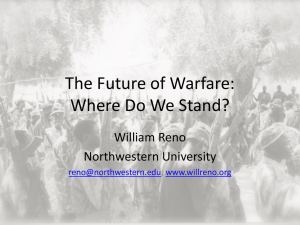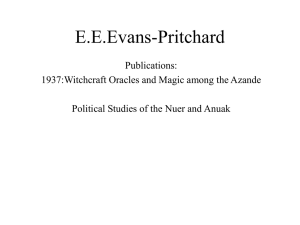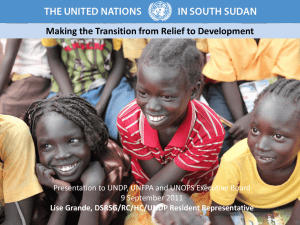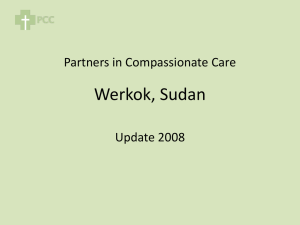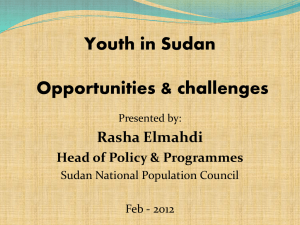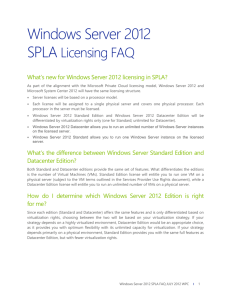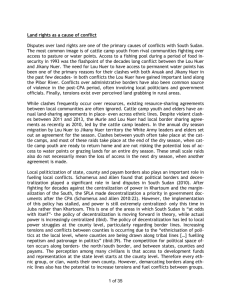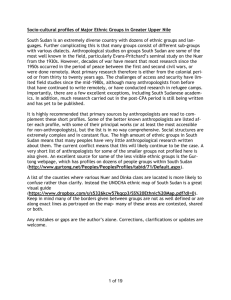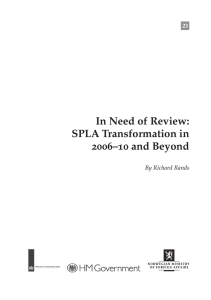this background document
advertisement
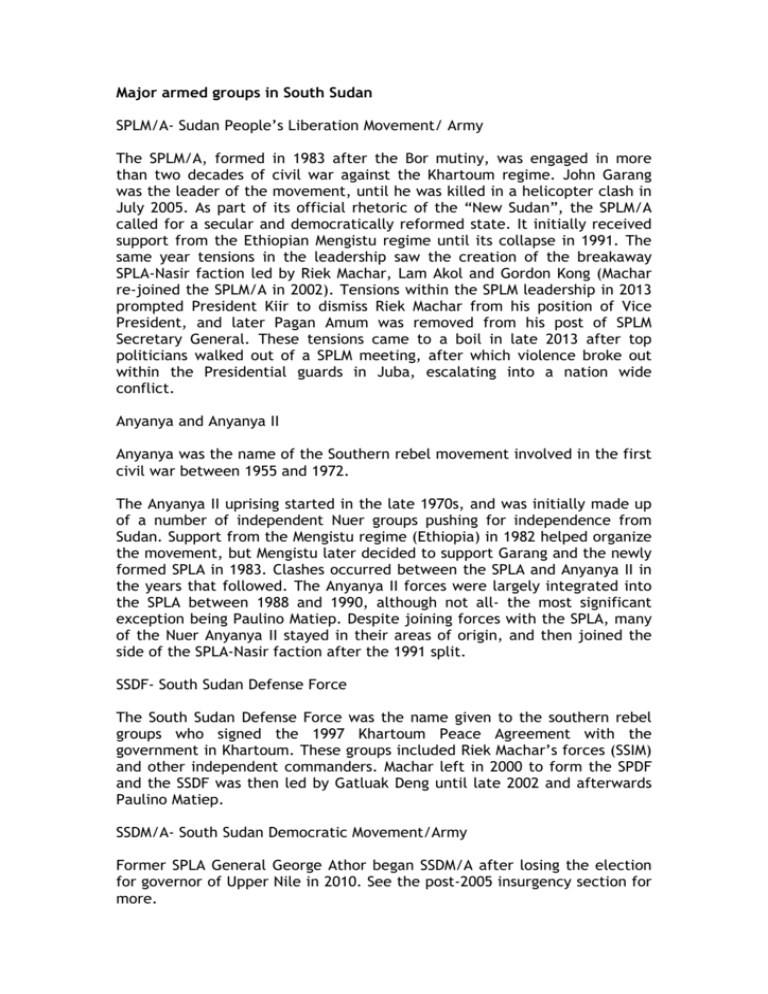
Major armed groups in South Sudan SPLM/A- Sudan People’s Liberation Movement/ Army The SPLM/A, formed in 1983 after the Bor mutiny, was engaged in more than two decades of civil war against the Khartoum regime. John Garang was the leader of the movement, until he was killed in a helicopter clash in July 2005. As part of its official rhetoric of the “New Sudan”, the SPLM/A called for a secular and democratically reformed state. It initially received support from the Ethiopian Mengistu regime until its collapse in 1991. The same year tensions in the leadership saw the creation of the breakaway SPLA-Nasir faction led by Riek Machar, Lam Akol and Gordon Kong (Machar re-joined the SPLM/A in 2002). Tensions within the SPLM leadership in 2013 prompted President Kiir to dismiss Riek Machar from his position of Vice President, and later Pagan Amum was removed from his post of SPLM Secretary General. These tensions came to a boil in late 2013 after top politicians walked out of a SPLM meeting, after which violence broke out within the Presidential guards in Juba, escalating into a nation wide conflict. Anyanya and Anyanya II Anyanya was the name of the Southern rebel movement involved in the first civil war between 1955 and 1972. The Anyanya II uprising started in the late 1970s, and was initially made up of a number of independent Nuer groups pushing for independence from Sudan. Support from the Mengistu regime (Ethiopia) in 1982 helped organize the movement, but Mengistu later decided to support Garang and the newly formed SPLA in 1983. Clashes occurred between the SPLA and Anyanya II in the years that followed. The Anyanya II forces were largely integrated into the SPLA between 1988 and 1990, although not all- the most significant exception being Paulino Matiep. Despite joining forces with the SPLA, many of the Nuer Anyanya II stayed in their areas of origin, and then joined the side of the SPLA-Nasir faction after the 1991 split. SSDF- South Sudan Defense Force The South Sudan Defense Force was the name given to the southern rebel groups who signed the 1997 Khartoum Peace Agreement with the government in Khartoum. These groups included Riek Machar’s forces (SSIM) and other independent commanders. Machar left in 2000 to form the SPDF and the SSDF was then led by Gatluak Deng until late 2002 and afterwards Paulino Matiep. SSDM/A- South Sudan Democratic Movement/Army Former SPLA General George Athor began SSDM/A after losing the election for governor of Upper Nile in 2010. See the post-2005 insurgency section for more. SSLM/A- South Sudan Liberation Movement/Army Peter Gadet began the SSLM/A in 2011 when he defected from the SPLA. After a few attacks he signed a ceasefire later that year, but other splinter factions who disagreed with his decision to sign a ceasefire continued to use the name.The SSDM/A and SSLM/A later joined into one movement around 2012, which can lead to confusion as the acronyms are often interchanged when speaking of movements such as Yau Yau’s. SSIM/A- South Sudan Independence Movement The South Sudan Independence Movement was the name taken by Machar’s faction in late 1994 (the earlier names being SPLA-Nasir and SPLA-United). The name was taken to highlight the group’s political goal of southern independence from Sudan, which was different from the official rhetoric of the SPLA. SSIM/A was a signatory to the Khartoum Peace Agreement in 1997 and it became part of the newly formed SSDF. Machar later left in 2000 to form the anti-government SPDF. SPLA-United The name SPLA-United has been used by two different groups, neither which exists today, which leads to confusion. Initially it was the new name for Riek Machar’s SPLA-Nasir faction between March 1993 and 1994. The addition of new individuals in the leadership led to a name change, and SPLA-United was selected to replace SPLA-Nasir. However, in 1994 the name changed again to SSIM/A. The second usage of SPLA-United was for the Shilluk movement of Lam Akol. Akol was expelled from the original SPLA-United by Machar in February 1994. When Machar changed the name of his movement to SSIM/A, Lam Akol took on the SPLA-United moniker for his own movement. The Lam Akol SPLA-United later joined the government in 1997 as part of the Khartoum Peace Agreement. SPDF- Sudan People’s Democratic Front/Defense Forces The Sudan People’s Democratic Front or Sudan People’s Defense Forces (the political branch and the military branch) were a rebel movement formed by Riek Machar in 2000. It later merged with the SPLM/A in January 2002. SPLA-Nasir The faction that split from the SPLA, led by Riek Machar, Gordon Kong and Lam Akol, in 1991 was initially called SPLA-Nasir, from the town in Upper Nile where they had their main base. This group later changed its name to SPLA-United in 1993, and then Riek Machar changed it to SSIM/A in 1994. SPLA-Torit/Mainstream After the 1991 split, those who remained loyal to John Garang came to be called SPLA Mainstream, to differentiate them from those who were loyal to the new faction(s). They were also called SPLA-Torit, as the town of Torit in Eastern Equatoria was the main base of Garang´s faction at the time. Red Army The Red Army, or Jesh Amer, was part of a military unit within SPLA, consisting of boys from many parts of the country. The boys received military training by the SPLA in the late 1980s and early 1990s. This occurred in refugee camps in Ethiopia, where only boys were placed, as well as schools within South Sudan - both of which were administered by the SPLA. (see Child Soldiers section for more details) White Army The White Army, or dec bor in Nuer (alternatively dech bor or dech en bor), is the term used to describe armed Nuer civilians who mobilize for defense and aggression. The White Army is primarily made up of untrained fighters, and is led and coordinated by youth leaders from within the community structures. The White Army first gained notoriety as a proxy militia in the wars within the SPLA in the 1990s on the side of the SPLA Nasir faction. In recent years it has been used as a means of defense and aggression in interethnic clashes between the Nuer and Murle ethnic groups in Jonglei. Currently it has sided with Riek Machar’s SPLA-in-Opposition due to the perceived threat towards Nuer, but once again it is largely independent and has its own parallel leadership structures. Titweng/Gelweng The titweng, or gelweng, literally translate as “cattle guards” in Dinka. After SPLA-Nasir raids into Dinka territory in the early 1990s the community demanded protection or weapons for self-protection. They received the weapons and training in how to use them. What began as a community defense structure turned into a proxy militia for SPLA-Torit/Mainstream. The group fought alongside the SPLA in 1997 in its push to capture Bahr al Ghazal. After the Wunlit Peace agreement between the Nuer and Dinka in 1999, the gelweng began to use the guns to fight amongst themselves, which led to a consequent SPLA disarmament in 2000. SSUM/A- South Sudan Unity Movement/Army The South Sudan Unity Movement/Army was started by Paulino Matiep in 1998. It included his earlier Anyanya II and SSDF forces and was supported by the Sudanese government. It was based in Mayom and was primarily made up of Bul Nuer. Smaller militia groups: Gabriel Tanginya, Gordon Kong and Simon Gatwich all had individual armed movements. They were supported by Khartoum and were made up of different Nuer sections. Tanginya’s militia was primarily Lak Nuer and was based in Fangak, Kong’s was primarily Jikany Nuer and was based in Nasir, and Gatwich’s was primarily Lou Nuer and was based in Waat. Johnson, Douglas. 2003. Root Causes of Sudan’s Civil Wars. Oxford: Currey. Human Rights Watch. 2003. Sudan, Oil and Human Rights. (https://www.dropbox.com/s/6wctp9hmacqksq1/Sudan%20Oil%20and%20Hu man%20Rights.pdf?dl=0) Small Arms Survey (www.smallarmssurvey.org) Key People John Garang de Mabior- Garang was the head of the SPLM and Commanderin-chief of the SPLA. He was shortly a member of Anyanya I but then was integrated into the Sudanese army at the end of the first civil war (1972). He rose to the rank of colonel and was initially sent to put down the Bor mutiny but then joined them. He was one of the founders of the SPLA in 1983 and received support from the Ethiopian Mengistu Regime over his southern rivals Anyanya II. Garang called for a secular and united Sudan, in contrast to Anyanya II’s demands for independence. He tragically died in July 2005 in a helicopter crash and Salva Kiir took over as the head of the SPLM and First Vice President of Sudan. Salva Kiir- Kiir was the chief of military operations for SPLATorit/Mainstream after the 1991 split and escorted thousands of children, and those accompanying them, to Kenya. Later Kiir was commander for Bahr al Ghazal in 1999 and strongly supported the Wunlit Peace agreement between the Dinka and Nuer. He was made SPLA Chief of Staff in late 1999 and then took over in 2005 as the head of the SPLM and commander-in-chief of the SPLA after Garang’s death. He won the first election for president and has held the position ever since. In December 2013 he accused his former Vice President Riek Machar, and others, of an attempted coup. The consequent violence in Juba escalated into the current conflict. Riek Machar- the first Vice President in South Sudan, but was dismissed by Salva Kiir in July 2013. Machar has historically had a tumultuous relationship with the SPLM/A and has been behind a number of factions over the years. Machar has been involved in SPLA-Nasir (which became SPLA-United and then SSIM/A), SSDF, SPDF and SPLA-IO. See the Nuer profile section for more details. Kuol Manyang- previously Manyang was the Governor of Jonglei state until his appointment in July 2013 as the Minister of Defense. As with many high level SPLM politicians Kuol Manyang was previously a high ranking official in the SPLA and was at one time in charge of the Bahr al Ghazal region. Gordon Kong- Kong was a veteran of Anyanya from the first civil war and was an original founder of the SPLM/A. He then joined the Anyanya II movement calling for independence between 1983 and 1988. He was central in the reconciliation of Anyanya II and the SPLA in the late 1980s when most of Anyanya II was integrated. He left the SPLA in 1991 as a leader of the SPLA-Nasir faction. After the 1997 agreement he was made a commander in the SSDF movement (pro-government umbrella group) and was based in Nasir. Lam Akol- Lam Akol was one of the leaders of the SPLA-Nasir faction in 1991 along with Gordon Kong and Riek Machar. He was expelled from the movement by Machar in 1994, after which he created his own SPLA-United group made up of Shilluk forces. His SPLA-United was a signatory to the 1997 Fashoda peace agreement. In 2009 he formed the SPLM-Democratic Change (DC) political party and ran against Salva Kiir for the presidency. See Shilluk profile section for more. Kerubino Kuanyin Bol- Kerubino was an Anyanya officer who was integrated into the Sudanese army after the 1972 agreement. He led the Bor mutiny and was part of the formation of the SPLA in 1983. He was put in prison by Garang in 1987 but escaped in 1992 and joined the SPLA-Nasir faction of Machar in 1993. Kerubino had a Dinka militia group under him that was supported by the Khartoum government from 1994. He later joined the SPLA in 1998 but then defected again later the same year and fled to Matiep’s SSUM/A in Mankien for safety. He was killed in September 1999 by Gadet’s forces who captured Mankien after defecting from Matiep that month. Peter Gadet- Gadet was originally a member of the Sudanese Army and was sent to fight on behalf of Saddam Hussein’s Iraq regime against the Iranians in the 1980s. He later joined the SPLA but joined the SPLA-Nasir faction after the 1991 split. He was then given an officer’s post under Paulino Matiep’s Bul Nuer forces. After the Khartoum Peace Agreement in 1997 Gadet became a key commander in Paulino Matiep’s SSUM/A militia. He then left the SSUM/A in September 1999 and fought against the Sudanese government. In early 2000 he joined the SPLA and then began to fight the SPDF forces under Machar later that year. In 2002 he then rejoined the government. Gadet was slow in accepting the Juba Declaration in 2006 which created suspicion when he began integration later. His brutal reputation while fighting with Paulino Matiep, then with the SPLA, and later with the SSDF also preceded him. Civilian populations were devastated in some of his attacks and many Bahr al Ghazal Dinka and Nuer in Unity hold significant grievances towards him to this day. Small Arms Survey believes his defection is related to the perception that former militia leaders were being overlooked for promotions, instead given to younger Dinka SPLA loyalists. He left the SPLA in March 2011 and started the SSLM/A movement. After attacks on Mayom and Mankien, in which more than 250 people were killed, he signed a ceasefire and later joined the government in August 2011. Gadet was one of the first to defect in December 2013 to the SPLA-IO and has been the commander for Jonglei, and more recently Unity state. Paulo Matiep- Matiep is unusual as he was never a member of the SPLA. Originally a member of Anyanya in the first civil war, Matiep was not integrated into the Sudanese Army after 1972, as many others were. He rebelled again in 1975 and went to Ethiopia and returned in 1985-1986 as Anyanya II. The reconciliation in the late 1980s between the SPLA and Anyanya II by Gordon Kong did not include Matiep, presumably due to attacks by the SPLA on Anyanya II in 1983. Matiep was supported by the government and fought alongside Omar Bashir (before the 1989 military coup that would put him in power until today) while recapturing Mayom in 1989 from the SPLA. He joined the SPLA-Nasir faction in 1991 and was integrated into the SSDF after the 1997 agreement. However, he fought against Machar´s SSDF forces from 1997 over the governorship of Unity, which was won by Taban Deng Gai. In 1998 he started the SSUM/A which was again supported by Khartoum. He then expelled Taban Deng from Unity in 1999. Taban Deng Gai- Twice governor of Unity, under both Sudan (1997-1999) and South Sudan (2005-2013). Taban Deng joined the SPLA in the 1980s but joined the SPLA-Nasir breakaway faction in 1991. He is related by marriage to Riek Machar. After the 1997 agreement with Khartoum, he became the leader of the new UDSF political party. He won an election to be governor of Unity in 1997 but was expelled in 1999 by Paulino Matiep. In 2000 he joined Machar’s new movement which then reunited with the SPLA in 2002. He was appointed as the governor of Unity again in 2005 and was seen as President Salva Kiir´s close ally. He won the contested elections in Unity state in 2010 against Angelina Teny, the wife of Riek Machar. However, over the last years he had a fall-out with the President who dismissed him from the governorship in 2013. Since December 2013 he has been a member of the SPLA-IO and represents them in the Addis peace talks. Ismael Konyi- Former governor of Jonglei and ally of Sudan as head of the Pibor Defense Forces (PDF) during the second civil war. Signed an agreement in 2006 with the GOSS and became a peace and reconciliation adviser to the president. David Yau Yau- After losing the 2010 parliamentary elections (state assembly) David Yau Yau began a rebellion in his home county of Pibor. Unlike many of the other movement leaders, Yau Yau had no previous military experience. He signed a peace agreement in 2011, but defected in 2012 after the brutal SPLA disarmament of the Murle at the beginning of the year. This time he received much more support from the youth, and his movement changed its name to SSLA- Cobra Faction. Interestingly, Gadet was the commander sent to lead the counter-insurgency operation against David Yau Yau in 2013 and captured the main base (in Boma?), but failed to kill Yau Yau himself. Yau Yau signed a new peace agreement with the government in 2014 providing for a newly created Greater Pibor Administrative Area (GPAA)1 that does not report to the state governor in 1 The new GPAA has seen two counties (Pibor and Pochalla) divided into seven new counties. Jonglei but to the president’s office instead. Yau Yau has been made the head of the GPAA. Johnson, Douglas. 2003. Root Causes of Sudan’s Civil Wars. Oxford: Currey. Human Rights Watch. 2003. Sudan, Oil and Human Rights. (https://www.dropbox.com/s/6wctp9hmacqksq1/Sudan%20Oil%20and%20Hu man%20Rights.pdf?dl=0) Small Arms Survey (www.smallarmssurvey.org)
